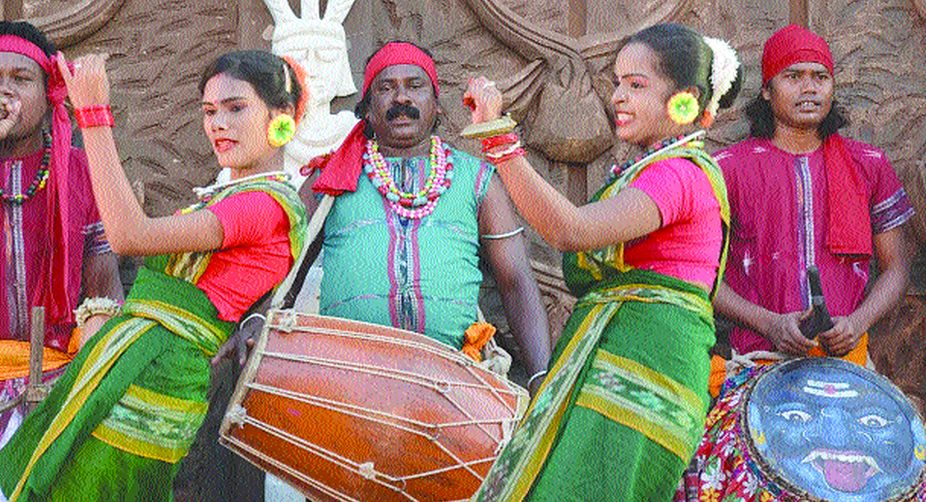Rahul Gandhi criticises BJP for naming ‘Adivasi’ as ‘Vanvasi’
The Congress MP accuses the saffron party of snatching their rights.

(Photo: SNS)
Ratan Thiyam’s wish to give back what has been taken away from the original inhabitants of the land is paying rich dividends. The so-called civilisation of man with all its scientific and technical advancements is a kind of self-destruction. From Adivasis (tribal people) we need to learn how to live and let live. It is for our own benefit that we should encourage them to live the life they have been living from time immemorial rather than make them imitate city folks.
It is the aim of Thiyam, chair man of the National School of Drama, to bring awareness to people about those who live with nature and not against it. With that in mind, he has been organising the Adivasi Adi Bimb festivals in places where a number of tribes live as well as cities like Mumbai. He has adopted Dwaronda village, which is home to many tribal communities. Dwaronda, where the Adivasi Adi Bimb festival is held, is about 16 km away from Santiniketan. In fact, Thiyam has been holding the festival there for four consecutive years now.
This time too, the festival not only provided a platform for dance, music and drama, but also held a crafts mela for exhibiting hand-made products by the adi vasis. An exhibition also showcased several musical instruments used by Adivasis besides their weapons. The three-day festival had at least 15 performing groups from different parts of the country. Festival concept and design was Thiyam’s while ambience design and decoration was provided by Anup Giri.
The make-shift performance area, in the football ground of the village, was made meticulously with mud and clay, and was large enough to provide space to groups of dancers. The backdrop of the open-air stage was done up with typical village and tribal motifs that revealed the aesthetic taste of its makers. There were separate performance places for singers and theatre artists. Huge statues of tribal gods adorned the ground besides other motifs put up in huge scaffoldings. Thiyam and actor/dancer/teacher Mamata Shankar, daughter of legendary Uday Shankar, inaugurated the festival.
It was a happy festive atmosphere and for three consecutive days, Dwaronda became the representative of mini rural India with troupes thronging the place in their traditional dance attires. The primitive Firkal dancers from Jharkhand had lots in store — male dancers came in to perform with all kinds of primitive weapons. A plethora of acrobatic movements were indeed jaw dropping as for example, lifting a water filled pot with the might of one’s teeth while going round in circles was indeed mind boggling. It was most interesting to watch porcupines eat up the yams cultivated by the Lepchas of Sikkim who are controlled by the power of the priests. They are all ears for the sounds of insects and birdsong, which tell them about the coming season rather than sit in posh apartments and look at calendars.
The Lepchas of Darjeeling, who call themselves Mutunchi Rongkup Rumkup, pray to Mt Kanchanjunga and pay obeisance to her. The Hozagiri dancers from Tripura who pray to Mainuma on the full moon day after Dussera had much in common with the Kojagori Lakshmi puja of the people of Eastern India. Even the name sounds similar. Hozagiri dancers were adept at balancing acts and several intricate feats that require great expertise. On the other hand, the influence of Hinayana Buddhism marked the dance of the Mogs of Tripura. Sangrain Mog Dance Academy performed much to the delight of all.
Khamti dancers of Assam, Cheraw dancers and Sarlamkai dancers of Mizoram told the story of their lives — agriculture for sustenance and fights with neighbours for rights — through dance. The Gubukudu performers of Bolangir came in singing Joy ma Sambal sariki joy and danced gracefully in the very popular Sambalpuri folk style. In the Koshli dialect, they continued the usual chant of Ei ghubukudu chang chang paisa thake pathre bhang, which entails begging for money with an empty tin box. The catchy tune induced swaying body movements among some in the audience.
The Jhum cultivators of Arunachal performed Adi Solung dance for giving them a bountiful harvest. On the other hand, Traditional Sringarik dancers from rural Kalahandi danced their way into the performance area to the rhythm of the dhol, mohuri, tasa, nishan and taal. Moli phul phula moho moho sang the vocalist and the dancers broke into performance eliciting answers from the Dholias in a spirit of madhur or romantic rasa.
Chhau dance from Jharkhand had gods, goddesses and demons of mythology as their theme. There was the enactment of the killing of the Demon Mahisasura by Durga who is known as Mahisasurmardini. Their leaps, jumps and somersaulting as well as costumes and masks enthralled the audience. Mising dancers of Assam performed a merry dance with the accompaniment of dhol, taal and bansi. They also presented Pu Yug: The withered canvas, a drama about the trials and tribulations of living on a river bank. Gohai Jatra by the people of Jharkhand was a drama on human trafficking while Lamana by Star Kamei of Manipur was based on the evils of blind faith. The ground was over-crowded and despite the biting cold, people came in their droves to the festival as it was their own. Adivasi Adi Bimb was a very enriching experience.
Advertisement